Daisy Aschehoug is an American quilter, designer and teacher currently living in Oslo, Norway. Just as you would imagine, Daisy’s quilts exude warmth, hygge, and a sophisticated style that evoke her Norwegian locale. Daisy began quilting almost eight years ago, familiar to most online as Ants-to-Sugar and an active member of North Carolina’s Triangle Modern Quilt Guild. Her family then relocated to Baton Rouge, and with the move came a transition in Daisy’s work. Her quilts took on a subtle sophistication, with layers of interest that gained notice of the Modern Quilt Guild. Daisy has since won numerous awards at numerous QuiltCons and her work has graced the cover of many magazines, including Love, Patchwork & Quilting. Most recently her quilts were recognized at QuiltCon 2018, including a Judge’s Choice award for her quilt, Hard to Handle. Newly rebranded as WarmFolk, Daisy now works and teaches classes in her new studio location of Oslo, Norway. In addition, she is the Communications Coordinator for SAQA, Studio Art Quilt Associates. She volunteers with Byverkstedet Project in the Holmlia neighborhood of Oslo teaching kids how to sew, and her quilt designs are featured as a part of the pattern collective, Quilt Theory. Welcome, Daisy!
How would you describe your quilting style/aesthetic?
Daisy: The power of basic geometry has always been important to me, and I like to try to surprise people by using simple elements in unexpected ways. Also, as a child, I loved seeing art in museums and feeling like it was something I could have created, but of course didn’t. I think that’s why I love designing with the constraint of patterning afterwards; everything I’ve made is meant to be recreated by someone else.
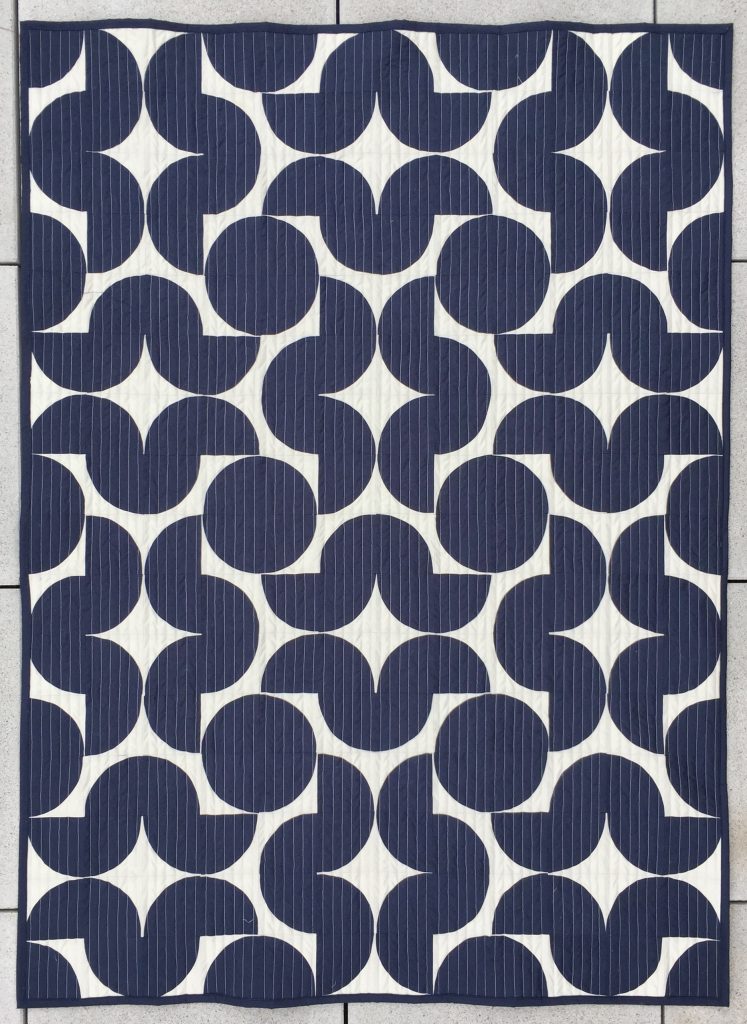
Fortune. Image courtesy of Daisy Aschehoug.
How would you describe the creative environment in your home as a child?
Daisy: At the time, I felt I was the only “creative element” in my environment. I got to take piano lessons and went to art classes and wrote poetry while everyone else did things that didn’t seem so creative. In hindsight though, I remember my dad always making and fixing things. I remember my mom gardening all the time and sewing all the costumes for Halloween and class plays. I remember my sister studying to become a brilliant doctor and scientist. I think that my understanding of “creativity” was limited to the arts, but there are so many ways to be creative. I now look back at my childhood and realize that every single influence in my life was busy inventing something new, which is the essence of creativity.
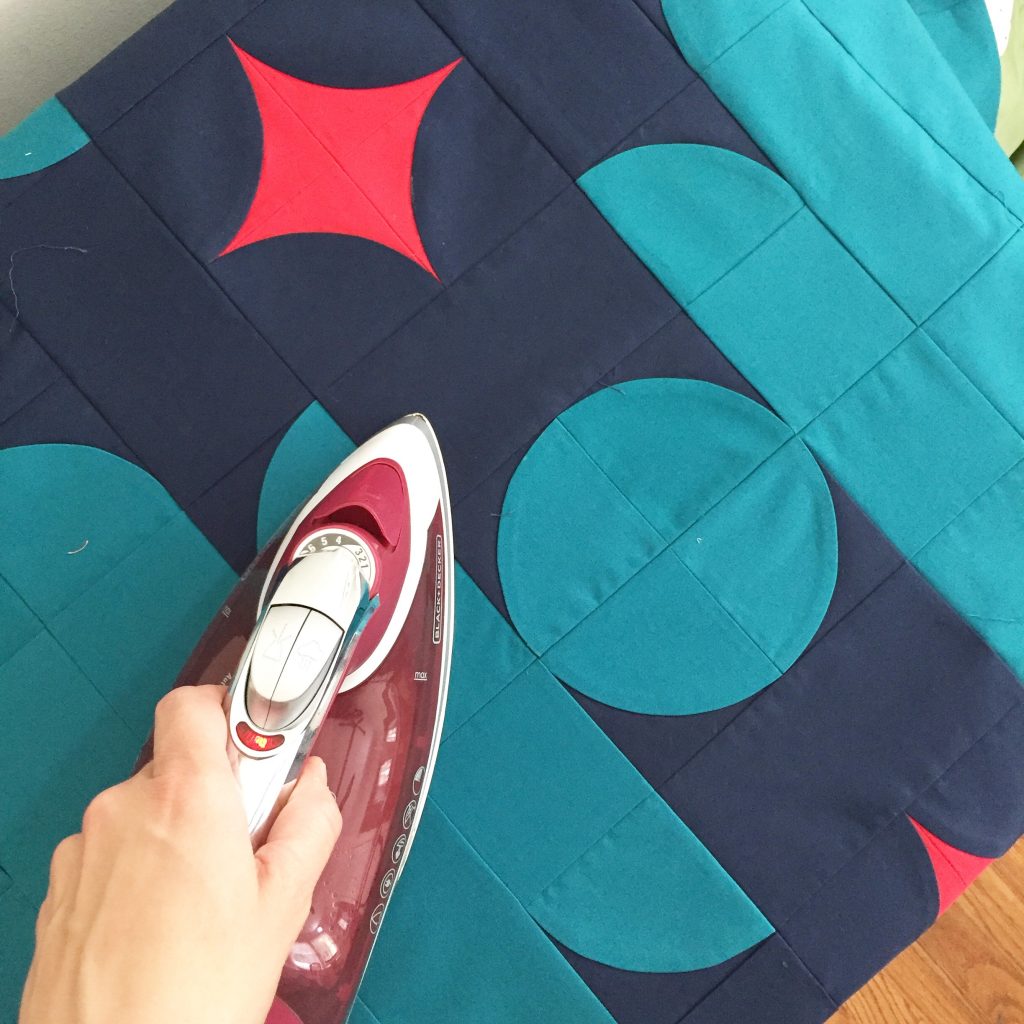
A shot of Daisy’s quilt Lantern Rouge in progress. Image courtesy of Daisy Aschehoug.
What artists and makers do you most admire or have an influence on your work?
Daisy: I love taking it ALL in. Sometimes my family is completely annoyed because I can’t make it from point A to B without stopping to contemplate how something looks and what I could create with the idea. I’m constantly evaluating the relationships between the shapes that I see, whereever it is that I see them. I look at architecture, nature, advertisements, graphic posters, art history, my kids drawings, and yes, other quilters. Quilters can make original work while being inspired by others. We don’t have to avoid each other. Early in my quilting, I followed Rachel @stitchedincolor and Sherri Lynn @sherrilynnwood very closely. They both taught me a lot (in different ways) about piecing techniques, use of color, and developing a style or voice. Over the years, I try to stop and reflect on who I admire in any given moment and why I’m curious about his/her work. If I had to narrow it to five right quilters now (and I really want to list more like fifty), I think I’d say Alexis @alexisdeise, Hillary @entropyalwayswins, Maritza @sotosewn, Timna @timnatarr, and Heidi @heidi.parkes. (first names + instagram accounts)
There are several natural dyers that I swoon over: Shelagh @stuartmoorestextiles, Maura @folkfibers, Alicia @botanical_threads, Sara B. @farmandfolk, and Rebecca @rebeccadesnos. I don’t want to start a new hobby and buy whatever one needs for natural dyeing, but I don’t think I can put it off much longer.
I also want to include the new quilt artist influences I’m finding as a relatively new member of the Studio Art Quilt Associates. Even though I’ve just found them, these quilt artists have been creating for decades: Michael James @michaeljamesstudioquilts, Nancy Crow, Leslie Tucker Jenison @leslietuckerjenison, Deborah Boschert @deborahboschert, Katie Pasquini Masopaust, and Maria Shell @talesofastitcher.
I’m a big fan of all the designers in Marimekko, particularly Sanna Annuka @sannaannuka. I recently stumbled onto Nick Barclay’s (@nick_b_designs) Three Color Cities posters, which led me to all of his other poster projects. I’m fascinated by Nick’s design exercises, and I’d like to do more of that in my own work. Lastly, I really enjoy the art prints of Jason and Kristina of @inaluxe.
And, just for kicks, I’ll mention I’ve got the documentary Tim’s Vermeer in the queue for my next movie night. I heard him speak a few weeks ago in San Antonio, and I’m intrigued by his tests of the theory that Vermeer used mechanical means to attain such accuracy in paintings. I’m curious about perspective, foreshortening, sight lines, and Vermeer’s use of light.
Do you consider yourself a “quilter”, an artist, or some combination of both?
Daisy: Sometimes either and sometimes a combination of both. My answer depends on my audience or what I’m wanting to talk about in the moment I’m asked. Sometimes I even say “designer,” because it’s easy to follow up with, “I design quilt patterns for magazines.” I want to point out that it took a while before I was willing to say artist. Maybe it was reading Elizabeth Gilbert’s Big Magic or listening to her podcasts, but I finally gave myself permission to start answering “artist” if that’s what I felt like saying when asked what I do.
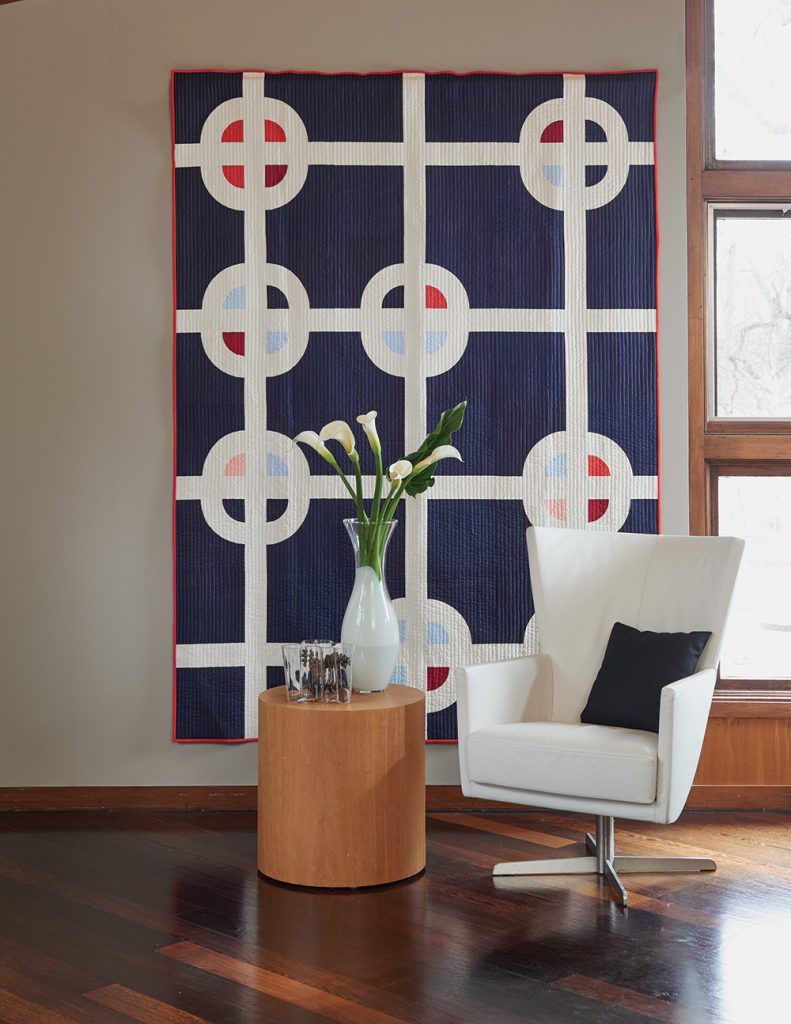
Sightseeing. Image courtesy of QuiltCon Magazine (2017).
How would you define “making with intention”?
Daisy: I don’t think it’s possible to make without intention. Even if I don’t have a plan, or a goal, or a purpose at the forefront of my mind, I know it is there should I decide to look for it. So I don’t worry about it. Sometimes I do worry that the idea of “making with intention” is meant to elevate, or give more importance to, certain crafters. With so much automation in our world, I think anything that is carefully and expertly constructed by hand is sacred, whether I can see the intention or not.
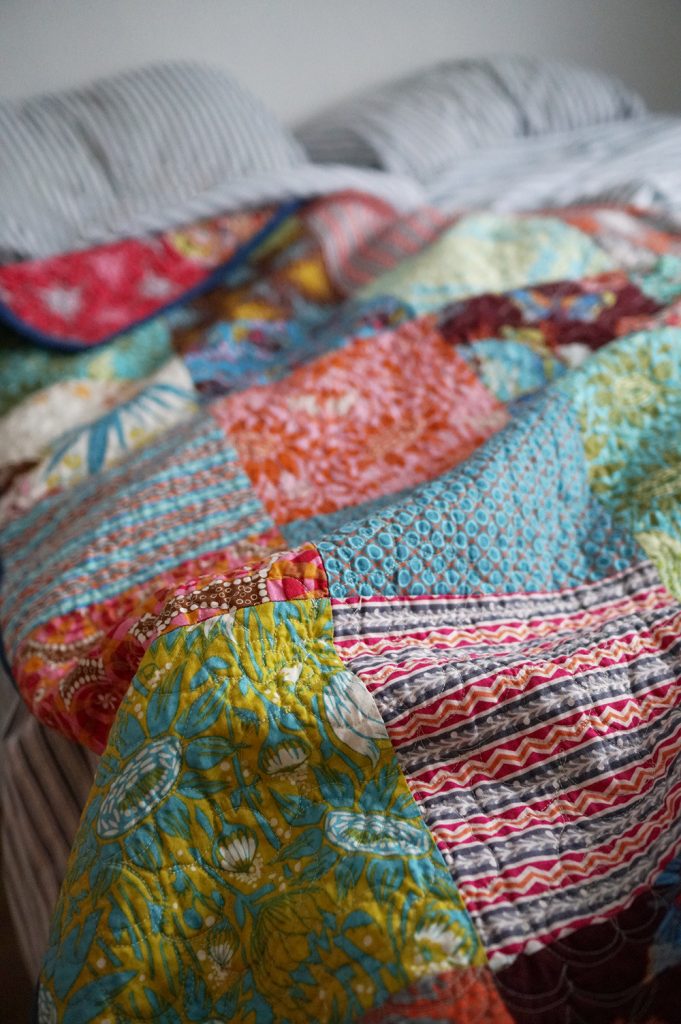
Daisy’s most loved quilt is a simple patchwork made up of Anna Maria Horner prints. Image courtesy of Daisy Aschehoug.
Do you think that having a craft makes us more compassionate? If so, then how?
Daisy: Nope. I don’t happen to know any, but surely there are some crafters who are real jerks. I like to think there might be more compassion in the crafting community, versus maybe the fine art community, because I think the heart of crafting is making something to be used, and to consider someone else as we work. But that’s not an airtight argument. So short answer is no, crafting doesn’t necessarily come with a side order of compassion. But it should.
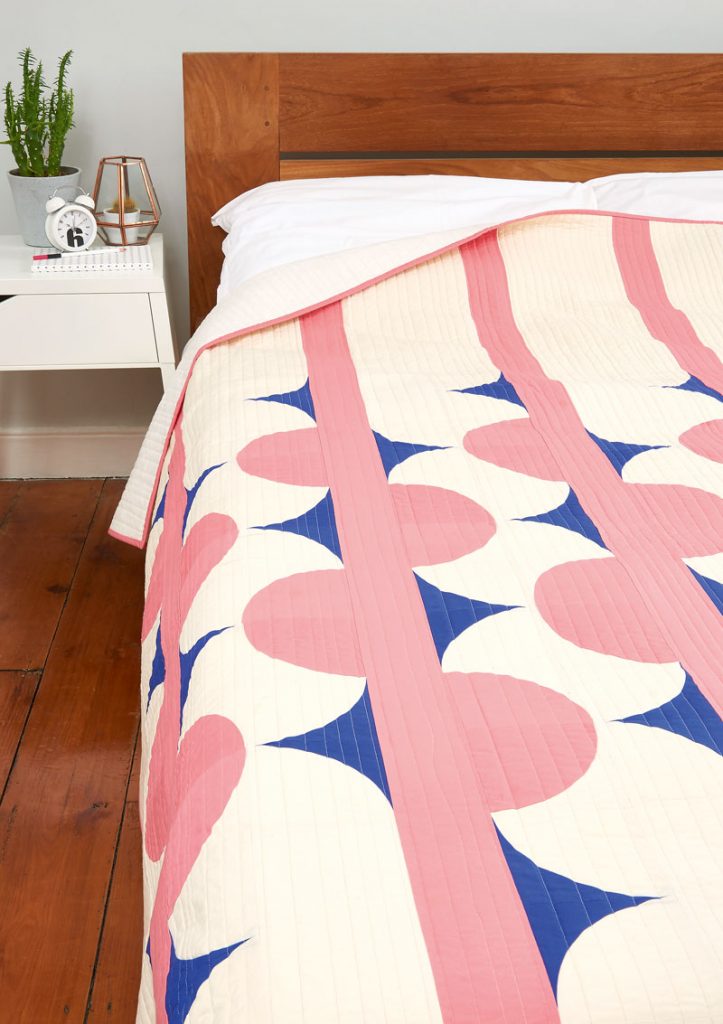
Daisy’s quilt Too Hard To Handle won a Judges Choice Award at QuiltCon 2018. Image courtesy of Love, Patchwork & Quilting Magazine.
How does creating feed your soul/spiritual purpose?
Daisy: Creating gives me a feeling of success that I can call my own. It’s the whole “I made that” sensation. The most creative time in my life was when I also felt like my own identity was dissolving into being a wife and mother. What I lost in quitting my job and selling my house and sacrificing my sleep, I created in discreet pieces of art that I could claim authorship of.
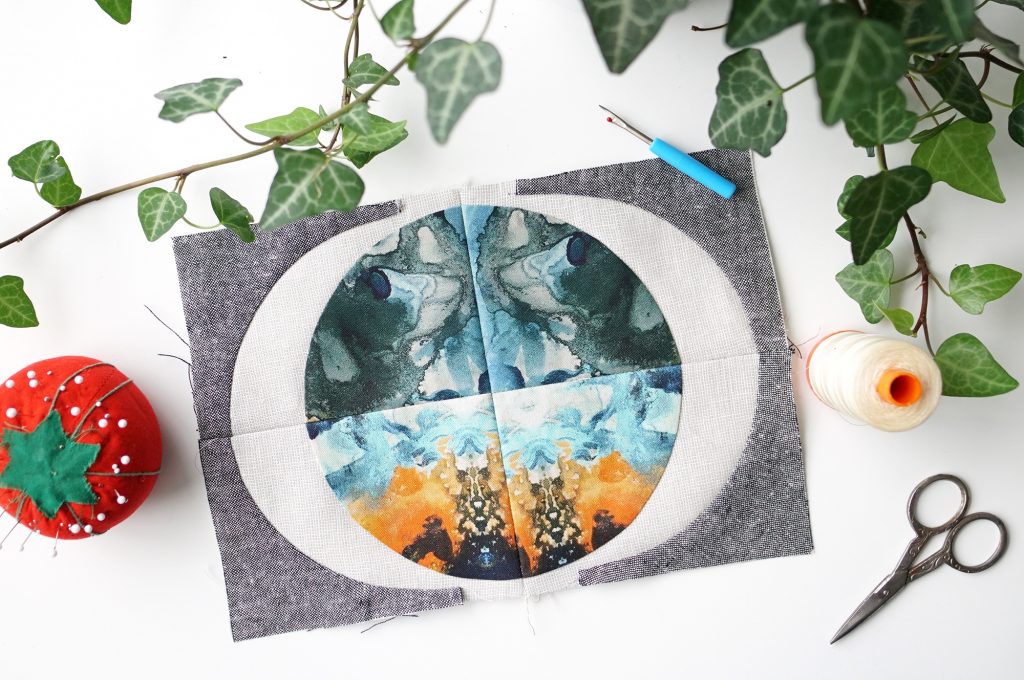
Eyes In Eyes Quilt Block. Image courtesy of Daisy Aschehoug.
Are there any rituals that you perform to prepare/ground yourself in your work?
Daisy: Espresso and procrastination.
What is the support system you have in place for creating your work?
Daisy: This is huge. I’ve not mentioned my parents or my spouse online before, but they have rallied around me in a way that I will never ever be able to properly thank them for. I was extremely depressed after my kids were born, and even though I felt like a black hole of neediness, they kept giving and helping and encouraged me to pursue quilting in the way that I wanted. My parents don’t live nearby, but they send activities for the kids and are always ready for conversations with the kids via facetime. My husband can step in at a moment’s notice – without instruction from me – to make dinner, do laundry, or get the kids ready for school with exactly what they need for the day (which somehow is a tremendous amount of stuff). I originally planned to stay at home and be the primary caregiver for our children. I changed my mind after our second child. We’ve reallocated responsibilities to reflect a more equal distribution of home chores so we can both have the space to be successful inside and outside our family life. Now that we live in Norway, it’s important for me to mention that the government subsidizes all preschools – and you are guaranteed a spot in a preschool no matter what. That kind of support system for small children seemed like only a dream when living in the US. Lastly, but also very important, is the network of peers whom I respect and depend on. Michelle Wilkie, Jenny Haynes, and Heather Black all provide invaluable input into my design work, and Rachel Justus has been my personal long-arm technical support and cheerleader. I’m probably leaving out something important, but hopefully I’ve made it clear that my support system is invaluable.
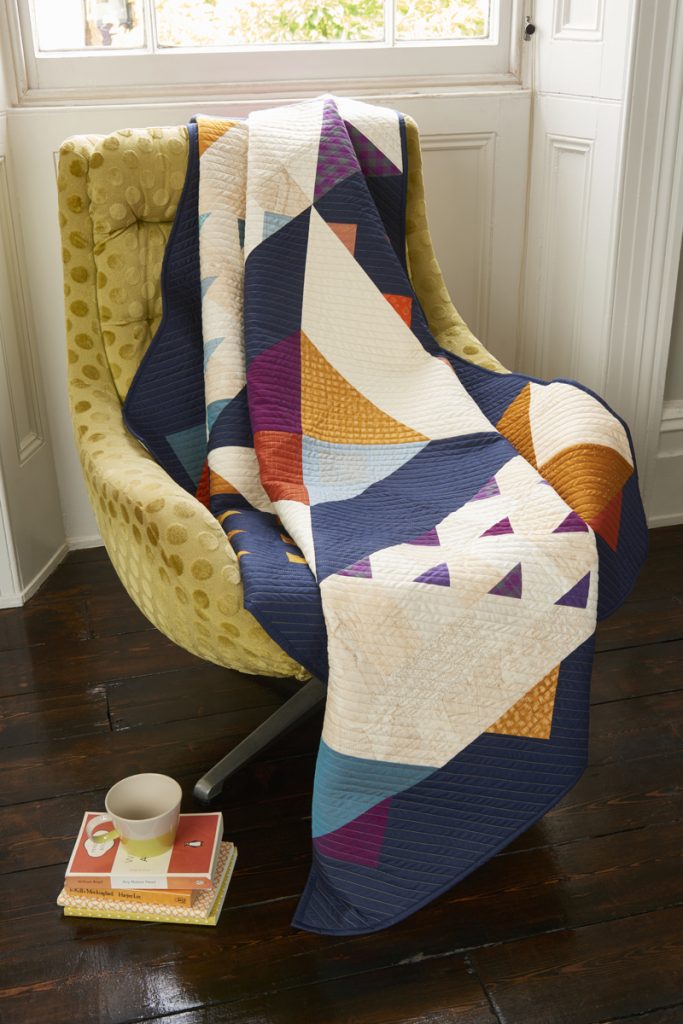
Autumn Hours. Image courtesy of Love, Patchwork & Quilting Magazine.
How do you deal with comparison to / envy of others? Can you describe a time when you used comparison/envy/admiration to push yourself in your own work and self-discovery?
Daisy: I am most active on things like Instagram when I am at peak creative productivity. When I’m busy with my day job or when the kids are sick and I’m not creating, and I look at others’ work and I think, “They’re awesome. I’m not doing anything.” And then I look at more work and see more people being awesome, and I keep feeling worse and worse and wasting more and more time and none of it helps me get back to creating.
But when I’m exercising my own creative voice, I feel good about joining in the conversation. Maybe it gets at the heart of success for me – which is just making something. Somehow, I’m not worried about making crappy art. I’m worried about wasting time and not making any art. So as long as I’m working, comparison is fine and can push me forward because I’ve got the time and space to be pushed forward. I avoid comparison when it stops serving me in a positive way.
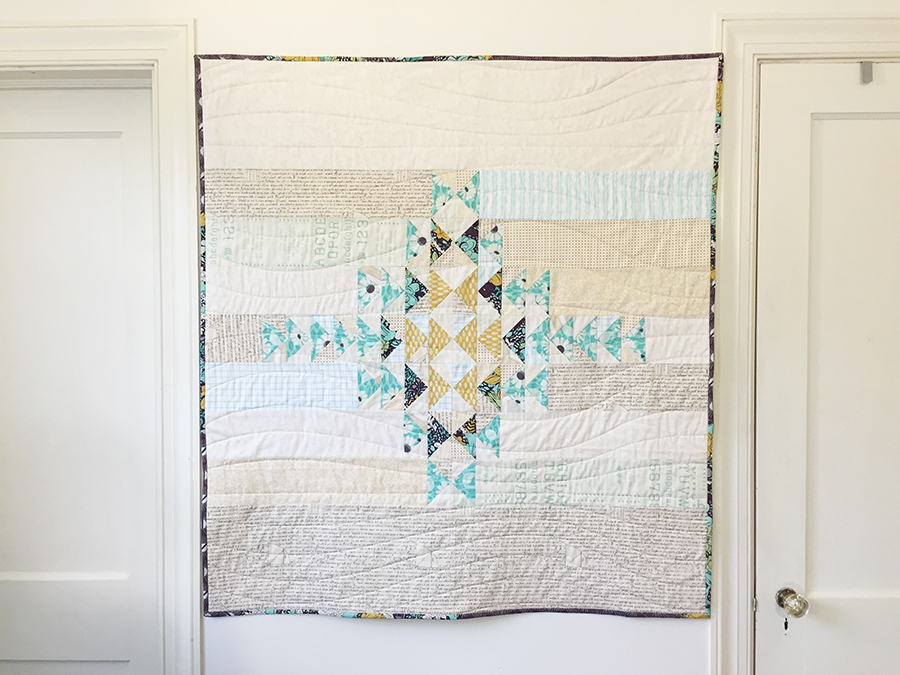
Come Together Quilt. Image courtesy of Daisy Aschehoug.
What was the most challenging thing you ever made?
Daisy: My biggest challenges happen when I submit a design to a magazine and it gets accepted long after the excitement about the design has passed. This aspect of quilting is a job for me, and I don’t turn away work. It’s much more fun to create something I’m excited about – no matter how technically challenging it might be. But even though I’ve had new ideas I’m more interested in exploring, I always go back and make the thing I said I would.
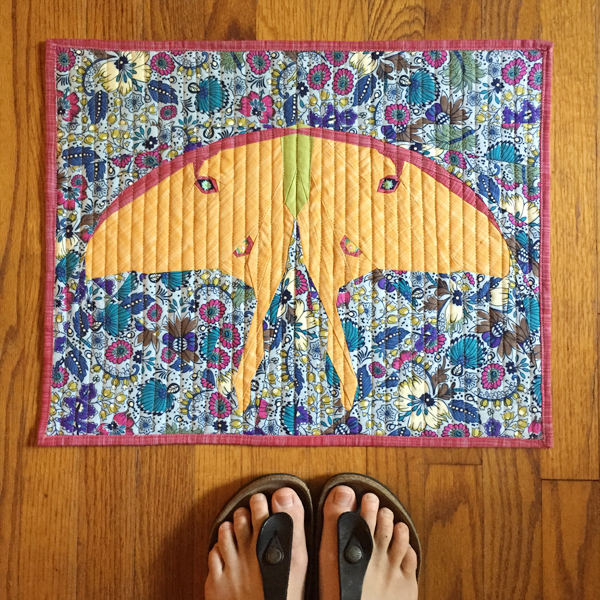
Luna Moth mini quilt. Image courtesy of Daisy Aschehoug.
What does it mean to you to work in a traditionally domestic medium that historically has been regarded as predominately female (aka “women’s work”)?
Daisy: Oh man. I’m not a great person to answer this question. I’ve always worked in areas that were interesting or exciting to me, and until now, I guess they’ve all been predominately male. This is the first time I’ve done anything that could be considered “female.” Is it insensitive to say I don’t really think about it being female? It means more to me to work in a medium that has a use – meaning I make something that can keep you warm even if it’s gosh-awful ugly. I contemplate the “art versus utility” debate much more than I think about this being women’s work.
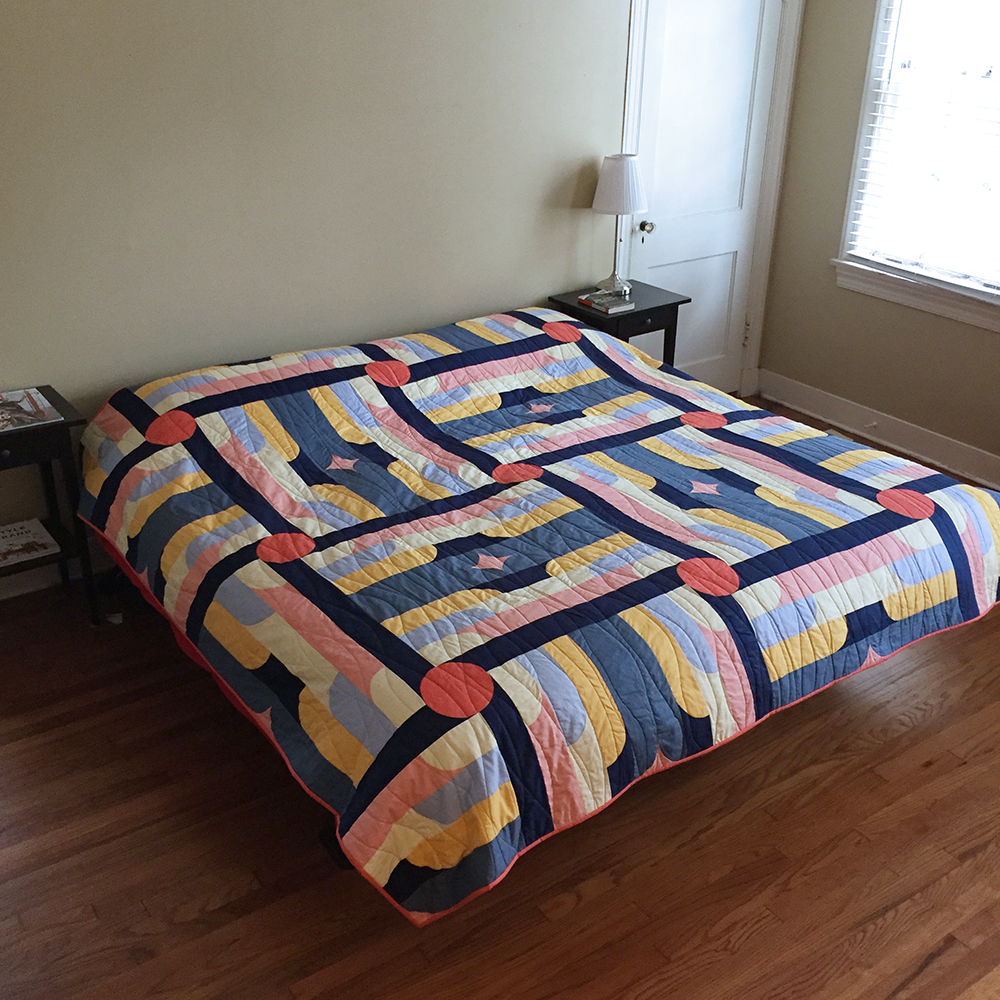
Wired quilt made for the RJR Fabrics What Shade Are You blog hop. Image courtesy of Daisy Aschehoug.
How do you see your current work in the context of quilting history?
Daisy: I don’t. I’m just not a big picture person. I make a quilt… and then another quilt… and then another…
Thank you, Daisy! It was so fun getting to know more about you! To learn more about Daisy, visit her website WarmFolk. You can also find Daisy on Instagram and Pinterest.
Would you like to be featured in The Creativity Project? I’d love to hear from you. Want to participate, but not necessarily be featured? You can do that! Click here to take the survey!
The Creativity Project can be found on Instagram, Pinterest, Twitter or Bloglovin’. Or sign up for my newsletter The Monthly Muse to have the Creativity Project delivered right to your inbox.
14 Comments
Comments are closed.

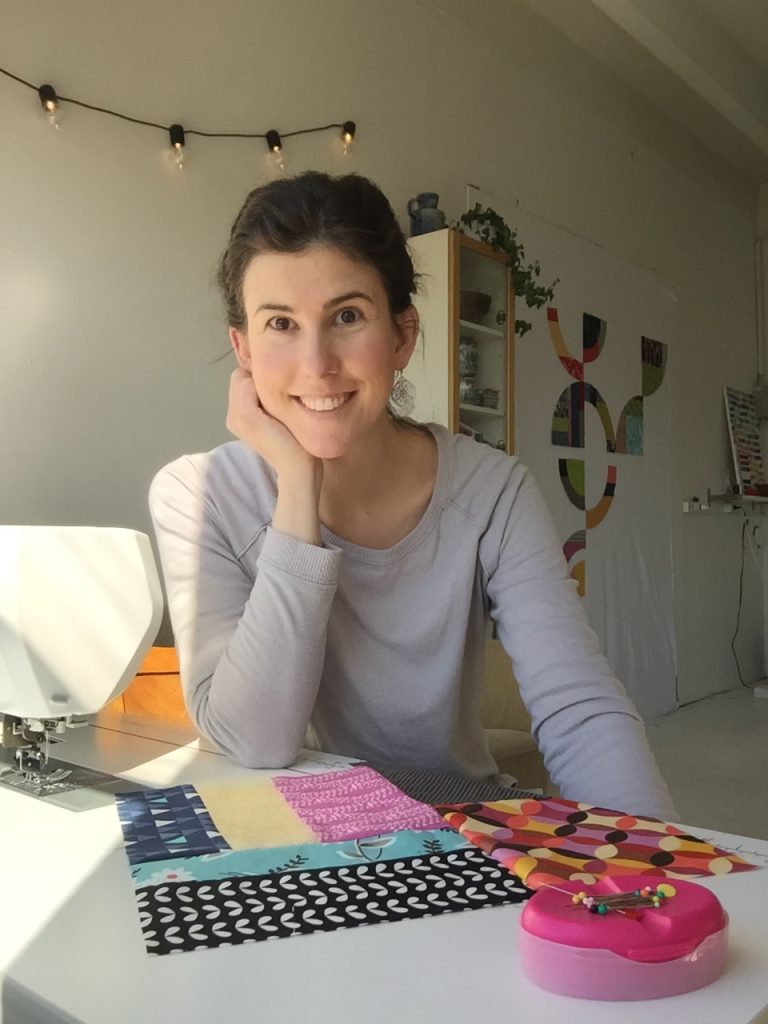
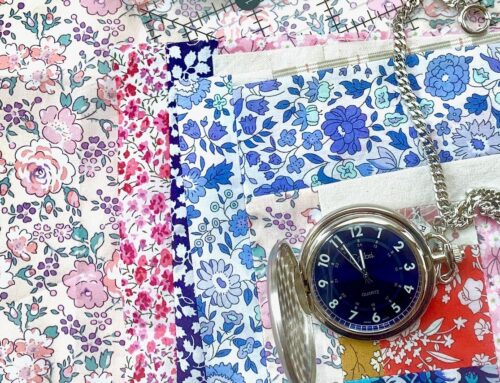
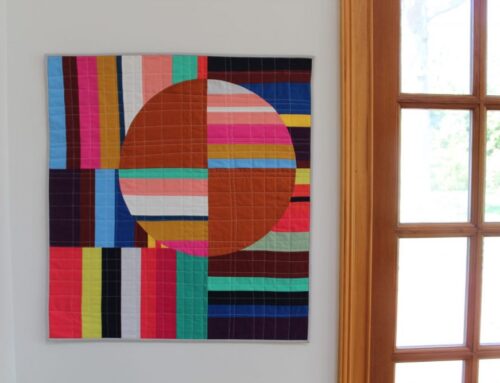
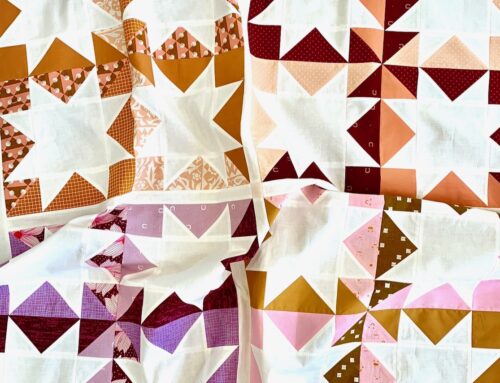

“I contemplate the “art versus utility” debate much more than I think about this being women’s work.” Me, too, Daisy.
I definitely fall on the “art quilts can be used” side of the debate and avoid the “art quilts must hang on walls” debate. I’d like to learn more and think about it more though…
I debate both questions frequently, and I honestly believe that both questions are very closely related, in spite of how non-related they might appear on the surface.
Agreed – same here.
I relate to so many of the things she says here, love this one, I want to be her friend! I’m so happy she named several quilters so I can look them all up! Thanks Daisy and Kim!!
Steph, I want to be YOUR friend! While I’ll never win a foot-drawing contest, we both married Norwegians – so clearly our friendship is meant to be. I hope our paths cross soon. :)
It is decided, we are friends! I thought you might have married a Norwegian, but I didn’t want to be presumptive. It’s funny that now that I look through your Instagram feed, I already have seen much of your work, not knowing it was yours.
I get the credit for introducing you two, right?!? ;)
So happy that you enjoyed and found some new inspiration!<3
Kim, I really appreciate being included, and I hope I’ve contributed something worthwhile to the project. I can definitely say I’ve gained so much from the self-reflection, and I appreciate our conversations as we put this interview together. Thank you!
Daisy, it has been such a pleasure working with you on this. I know how much thought you put into so many of your answers, and I really enjoyed discussing some of the issues raised in the interview offline. I love that the project gave you time for self-reflection that you can use to the benefit of your work, and I hope that we can continue to be in touch and to talk more about these topics in the future! Thank you so much for participating!
I too have seen a lot of Daisy’s work without connecting it to her. I love the clean lines.
Another great read Kim. I thought this was an interesting perspective: “With so much automation in our world, I think anything that is carefully and expertly constructed by hand is sacred, whether I can see the intention or not.” I hadn’t thought of it exactly like that but this is part of what draws me to want to make things. It used to be commonplace to sew, make clothing, quilts etc. Now everyone is busy and doesn’t necessarily see the value in making something of your own.
Yes! It’s a way to implement mindfulness when we take the time to make something that we have a choice to purchase!